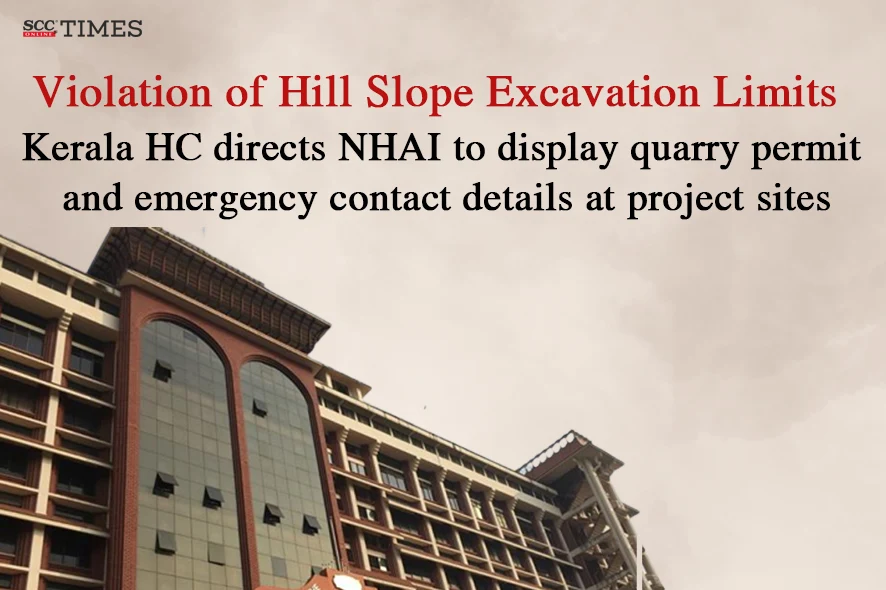Kerala High Court: In a public interest litigation filed by residents of Chelannur Panchayath, Kozhikode, the petitioners highlighted the absence of an effective mechanism to inform the authorities when the excavation of hill slopes exceeded permissible limits, thereby posing a threat of slope destabilization. The division bench comprising Nitin Jamdar*, C.J., and Basant Balaji, J., disposed of the petition after accepting the statement made on behalf of the National Highways Authority of India (‘NHAI’). The Authority undertook to issue necessary instructions to the concessionaire, either by separate communication or by incorporating the requirement into the agreement, to erect metallic boards at regular intervals along the stretch of road where quarrying activities are conducted. These boards are to display the information mandated under Rule 10(i) of the Kerala Minor Mineral Concession Rules, 2015, as well as the contact details of the officer in charge of the relevant Project Implementation Unit (‘PIU’).
Background
The petitioners alleged that soil extraction was being carried out in connection with the construction of the National Highway from Kasaragod to Thiruvananthapuram, where soil had been extracted beyond the permissible limits, altering the hill’s topography and causing severe environmental damage, including the risk of landslides. The excavation had affected an area inhabited by over 100 residents, with schools and temples located nearby, and had also led to pollution of the river.
The District Geologist visited the site and submitted a report stating that the conditions of the quarrying permit had been violated. In a report dated 4-12-2024, the Geologist cautioned that there was a high possibility of the bund collapsing during heavy rains, which could flood nearby roads and houses.
The petitioners sought directions to immediately halt the unscientific excavation of excessive soil and to implement adequate safety measures, including slope stabilization, to prevent further harm to the residents.
Analysis and Decision
The Court noted that when the petition came up for hearing on 18-12-2024, it had, after considering the communication from the Geologist to the District Collector, placed the responsibility on the District Collector to ensure that there was no breach of legal provisions or permit conditions, and to take appropriate action in the event of any violation.
Subsequently, in accordance with the order dated 4-02-2025, a memo along with the report of the District Collector was filed, stating that, based on the Geologist’s findings, necessary steps were being undertaken to ensure that quarrying activities remained within the permissible limits. With respect to the unscientific and excessive extraction of soil, the Court further observed that continuous monitoring would be essential to ensure that licence holders did not exceed the scope of their quarrying permits.
It was placed on record that the complaints raised by the petitioners had been addressed, and that the required precautionary measures had been implemented under the supervision of qualified engineers.
The Court observed that the steps taken by the authorities were reactive and implemented only after the damage had already occurred. It noted that, had timely action been taken, the environmental harm could have been avoided. Consequently, the core issue that arose for consideration was the absence of a feedback mechanism for residents in cases of urgency.
The petitioners submitted that when hill cutting or excavation for road construction is carried out on hill slopes, local residents do not have any designated authority to contact in emergencies, delays in such situations could prove fatal. In light of this, the Court directed the State of Kerala, the Ministry of Environment, Forest and Climate Change, and the Kerala State Pollution Control Board to submit their responses regarding the existing on-site monitoring mechanisms, the channels available for local residents to lodge complaints, and the measures in place for immediate intervention by the authorities.
The Court emphasised that Rule 10(i) of the Kerala Minor Mineral Concession Rules, 2015 (‘Rules, 2015’) mandates the display of a board at the site, containing contact details of the permit holder and other relevant authorities. The Court noted that this requirement forms part of the conditions under which quarrying permits are granted and is intended to facilitate transparency and public access to information in case of emergencies or violations.
The Court stressed that Rule 10 of the Rules, 2015 requires the permit holder to erect a notice board in Malayalam at a prominent location, using a metallic board placed near the entrance of the quarry. Since the concessionaire would be deemed the permit holder under Rule 10 of the Rules, 2015, the Court had directed the NHAI to place on record whether the agreement entered into between the NHAI and the concessionaire contains any specific obligation to install such a board at a prominent location.
The Court noted that NHAI had submitted an affidavit sworn by the Project Director, placing on record a sample concessionaire agreement to demonstrate that the terms of the agreement included a clause requiring the concessionaire to undertake or perform all acts necessary in accordance with the agreement, applicable laws, and permits. NHAI submitted that this would encompass compliance with Rule 10(i) of the Rules, 2015, which mandates the erection of a metallic board near the entrance of the quarry displaying the relevant contact information.
However, the petitioners contended that in cases where quarrying activities are carried out along a stretch of road for the NHAI, the requirement of erecting a metallic board specifically “near the entrance of the quarry” is impractical. NHAI accepted this position and, upon instructions, proposed that metallic boards containing the information stipulated under Rule 10(i) could instead be erected at regular intervals along the road, at locations deemed appropriate and necessary.
The Court found this suggestion and the stand taken by the NHAI to be appropriate.
The Court observed that the next issue for consideration was whose contact details should be displayed on the board. The primary concern raised by the petitioners during the hearing was their inability to immediately contact a relevant authority or responsible person in the event of an emergency.
NHAI submitted that PIUs are established for specific areas and suggested that the contact details of the officer in charge of the relevant PIU, including phone number, email address, and other means of communication could be displayed on boards placed at regular intervals along the road where quarrying activities are undertaken. The Court found this suggestion reasonable, noting that such an initiative would at least provide local residents with the opportunity to contact a responsible official in case of an emergency.
Proceeding on the basis of the suggestions by the parties, as well as in light of the requirement under Rule 10(i) of the Rules, 2015, the Court disposed of the petition by accepting the statement made on behalf of the NHAI. The Authority undertook to issue necessary instructions to the concessionaire, either through a separate communication or by incorporating the stipulation into the agreement, to erect metallic boards at regular intervals along the stretch of the road where quarrying is being carried out. These boards shall display the information required under Rule 10(i) of the Rules of 2015, as well as the contact details of the officer in charge of the relevant PIU.
Further, the Court recorded that steps shall be taken, in accordance with law, to incorporate this stipulation into future agreements where the contract is of a similar nature.
Accordingly, the writ petition was disposed of in the above terms.
[Pradeep Kumar P. v State of Kerala, 2025 SCC OnLine Ker 5686, decided on 30-07-2025]
Advocates who appeared in this case:
For Petitioners: Vinod Singh Cheriyan, T.M. Khalid, K.P Susmitha, Jeswin James, P.B. Sahasranaman
For Respondents: Lejo Joseph George, T.Naveen SC, Kerala State Pollution Control Board, Mathews K. Uthuppachan, Atul Mathews, B.Rahul Krishnan, V. TEchchand-SR.GP, B.G Bidan Chandran-SC, T.Naveen, SC, Kerala Pollution Control Board



